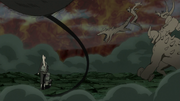Omnibender (talk | contribs) No edit summary |
(Databook info) Tag: rollback |
||
| (One intermediate revision by one other user not shown) | |||
| Line 10: | Line 10: | ||
|parent jutsu=Shadow Imitation Technique |
|parent jutsu=Shadow Imitation Technique |
||
|jutsu rank=A |
|jutsu rank=A |
||
| − | |jutsu classification=Hiden~Nara, Ninjutsu |
+ | |jutsu classification=Hiden~Nara Clan, Ninjutsu |
|jutsu type=Yin Release |
|jutsu type=Yin Release |
||
|jutsu class type=Supplementary |
|jutsu class type=Supplementary |
||
| Line 22: | Line 22: | ||
|jutsu media=Anime, Manga, Game |
|jutsu media=Anime, Manga, Game |
||
}} |
}} |
||
| − | The user materialises |
+ | The user materialises their shadow and increases its power, becoming like steel. The user then captures the target's shadow and forcibly moves them about. The techniques strength is proportionate to the chakra put into it, with enough strengh even giants can be moved. When used together with the Akimichi's [[Human Bullet Tank]], it turns it into a weapon. This simple application makes it useful in a number of emergency situations. Unlike with the [[Shadow Imitation Technique]], though the two shadows are connected, the target is not forced to copy the user's movements, allowing them to retain their own range of motion. |
== References == |
== References == |
||
Revision as of 20:44, 9 December 2014
The user materialises their shadow and increases its power, becoming like steel. The user then captures the target's shadow and forcibly moves them about. The techniques strength is proportionate to the chakra put into it, with enough strengh even giants can be moved. When used together with the Akimichi's Human Bullet Tank, it turns it into a weapon. This simple application makes it useful in a number of emergency situations. Unlike with the Shadow Imitation Technique, though the two shadows are connected, the target is not forced to copy the user's movements, allowing them to retain their own range of motion.
References
- ↑ Fourth Databook, page 238

